Ah, thanks, I'd overlooked the adoption of compulsory education, and how battles were "won on the playing fields of Eton" or whatever. Was teamwork something they stressed in sports at the time?To a large extent, it was deliberate.
The main vehicle of social engineering was the education system, which was still a relatively new concept in the nineteenth century. Poor children only went to school for a couple of hours a day because many of them had full time jobs. Their education had two purposes. Firstly, to improve the quality of the work force by teaching basic skills like literacy, and secondly to instill bourgeois social and moral values. The latter was accomplished through a very extreme emphasis on discipline and the extensive, use of corporal punishment. Corporal punishment is pretty normal in history the world over, but it became extremely institutionalized in the British education system. I don't think any society has ever delighted quite as much in the act of beating children.
Male children of the social elite, on the other hand, recieved a full time education at public school, and this is where it becomes extremely deliberate. The curriculum and the entire school experience of early public schools was very intentionally designed to foster certain behaviors, viewpoints and attitudes thought to be conducive to military service. This was both overt and covert. Overtly, the curriculum was meant to instill patriotic ideas and a sense of national and class superiority and knowledge of the world that might be useful to a military officer. Covertly, there was an unprecedented emphasis on competitive team sport, for example, because this was seen as a way of preparing children for war, (both physically in terms of conditioning but also mentally in terms of fostering toughness and aggression). This wasn't much of a secret, in fact. It was pretty obvious to anyone who went through the system, although it wasn't until after the first world war that people started to openly reflect on the way school had influenced them.
It does little for me musically, but I find Pink Floyd's album and film The Wall kind of historically fascinating because, by my reading, it seems to be about the experience (which I also recognize in my own parents) of growing up in the cultural space between Imperial Britain and modern Britain, with all the contradictory values and ideological failure that implies. A lot of it is deeply personal and autobiographical of Waters personal trauma, but it also implies a societal trauma that I think is very real and at the root of a lot of what is wrong with this country now. In order to feel good about helping to defeat fascism, we've kind of all had to repress the psychological similarities between Imperialism and fascism and conveniently forget a huge part of our own historical identity.
Funny events in anti-woke world
- Thread starter Agema
- Start date
Many Indigenous Australians fell for the double V idea like the African Americans"Abbott went on to claim “hundreds of Aboriginal men would not have signed up to fight for king and country in 1914 and 1915 if they had been the subjects of a racist empire”."
I find it hard to believe this is anything other than gross dishonesty: because people like Abbott cannot be unaware of the grim history of what went on in history, and cannot seriously believe the British Empire wasn't shot through with racism from top to bottom.
I should note that Abbot is generally seen as having a positive attitude towards Indigenous Australians.... for a conservative. That does not mean that he doesn't think that the British Empire did everything right. He just thinks they are unrelated
Either that, or they saw the opportunity for a steady paycheck and didn't necessarily realize it came with a one way ticket to the world's least fun beach party.Many Indigenous Australians fell for the double V idea like the African Americans
That’s certainly one way to describe Gallipoli.Either that, or they saw the opportunity for a steady paycheck and didn't necessarily realize it came with a one way ticket to the world's least fun beach party.
I would dispute this to some degree, in the sense that I don't think British generals treated white colonial troops as cannon fodder any more than they did British troops. Gallipoli was a seminally traumatic baptism of fire for the ANZAC, but well over half the troops were British and the British did well over half the fighting and dying, too.The empire used Australians, Canadians and other white settler minorities as cannon fodder. They were sent to storm fortified beaches at Gallipoli because it didn't matter if they took high casualties.
Plus, of course, it has to be contextually placed in the "meat-grinder" element of WWI: Verdun, the Somme, etc. Most generals didn't really view their troops as cannon fodder, they just had orders to do something and didn't know what else to do to avoid massive casualties. (I might be less generous to politicians at a safer remove from the frontlines.)
This is genuinely sickening.
CPAC Australia: hardline culture warriors rail against Indigenous voice, ‘fake news’ and ‘woke corporates’
Tony Abbott, Warren Mundine and Jacinta Nampijinpa Price were among those urging attendees to oppose the voice to parliamentwww.theguardian.com
America is exporting its psychotic political circus and attempting to infect australian politics, and the australian fascists are all in for it.
A leprous ebola curse on all those involved.
I'd agree. This is (British) elites using everyone elseI would dispute this to some degree, in the sense that I don't think British generals treated white colonial troops as cannon fodder any more than they did British troops. Gallipoli was a seminally traumatic baptism of fire for the ANZAC, but well over half the troops were British and the British did well over half the fighting and dying, too.
Plus, of course, it has to be contextually placed in the "meat-grinder" element of WWI: Verdun, the Somme, etc. Most generals didn't really view their troops as cannon fodder, they just had orders to do something and didn't know what else to do to avoid massive casualties. (I might be less generous to politicians at a safer remove from the frontlines.)
It's not about nationalities, it's about elites and others
Well...yes, but then there's no reason that class has to be the only issue. That British people in Britain were seen differently to British people in British colonies isn't that outlandish.I'd agree. This is (British) elites using everyone else
It's not about nationalities, it's about elites and others
OTOH, at least at Gallipoli, a lot of the Australian forces were actually English. And a lot of the New Zealanders were Australian.

Elon Musk’s Reported $10 Million Donation to Fertility Research Is Deeply Unsettling
Just another day of fearmongering about birth rates for the billionaire father of 10.
 jezebel.com
jezebel.com
American businessman planning his post-apocalyptic warlord fantasy.

 www.theguardian.com
www.theguardian.com

US businessman is wannabe ‘warlord’ of secretive far-right men’s network
Revealed: Charles Haywood, creator of the Society for American Civic Renewal, has said he might serve as ‘warlord’ at the head of an ‘armed patronage network’
Absent
And twice is the only way to live.
- Jan 25, 2023
- 1,594
- 1,558
- 118
- Country
- Switzerland
- Gender
- The boring one
I know that conservatives seldom get who is supposed to be the good guy or the bad guy in films like "Scarface" or "Wall Street". But I'm surprised by how often it happens with "Mad Max".
Obviously it's Furiosa for stealing the spotlight from Max and emasculating him.I know that conservatives seldom get who is supposed to be the good guy or the bad guy in films like "Scarface" or "Wall Street". But I'm surprised by how often it happens with "Mad Max".
How are his kids supposed to stay rich if the rest of us don't have a bunch of kids for them to exploit?
Elon Musk’s Reported $10 Million Donation to Fertility Research Is Deeply Unsettling
Just another day of fearmongering about birth rates for the billionaire father of 10.jezebel.com
Absent
And twice is the only way to live.
- Jan 25, 2023
- 1,594
- 1,558
- 118
- Country
- Switzerland
- Gender
- The boring one
Increased fertility. The conservative answer to school shootings.How are his kids supposed to stay rich if the rest of us don't have a bunch of kids for them to exploit?
For the units raised in South Australia a fair percentage of the troops were actually German.OTOH, at least at Gallipoli, a lot of the Australian forces were actually English.
Those people are the same type of jackasses that root for assholes like Senator Armstrong, Makoto Shishio, Patrick Bateman, Tyler Durden, or Light Yagami. Some of them will even root for Joker or Johan Liebert, because so long the former only kills people they dislike, and because he is a "survivor that kills the strong and gets things done with nobody to answer to". The second guy for similar reasons, but he's younger, more handsome looking, and is a blonde blue-eyed guy. Though these idiots forget and don't realize is that neither one actually cares about race nor Nazi ideology. Joker hates Nazis and skinheads. Johan finds them not evil enough, and killed them when they were no longer needed and doesn't care for the racist ideology either. He found them too weak and pathetic.I know that conservatives seldom get who is supposed to be the good guy or the bad guy in films like "Scarface" or "Wall Street". But I'm surprised by how often it happens with "Mad Max".
They're pretty good at telling who the bad guy is when the villain is a woman or a minority with a sympathetic goal and backstory like Killmonger, Namor or Evil-Lyn.I know that conservatives seldom get who is supposed to be the good guy or the bad guy in films like "Scarface" or "Wall Street". But I'm surprised by how often it happens with "Mad Max".
*Funky spy music plays*
Or just play this while reading.
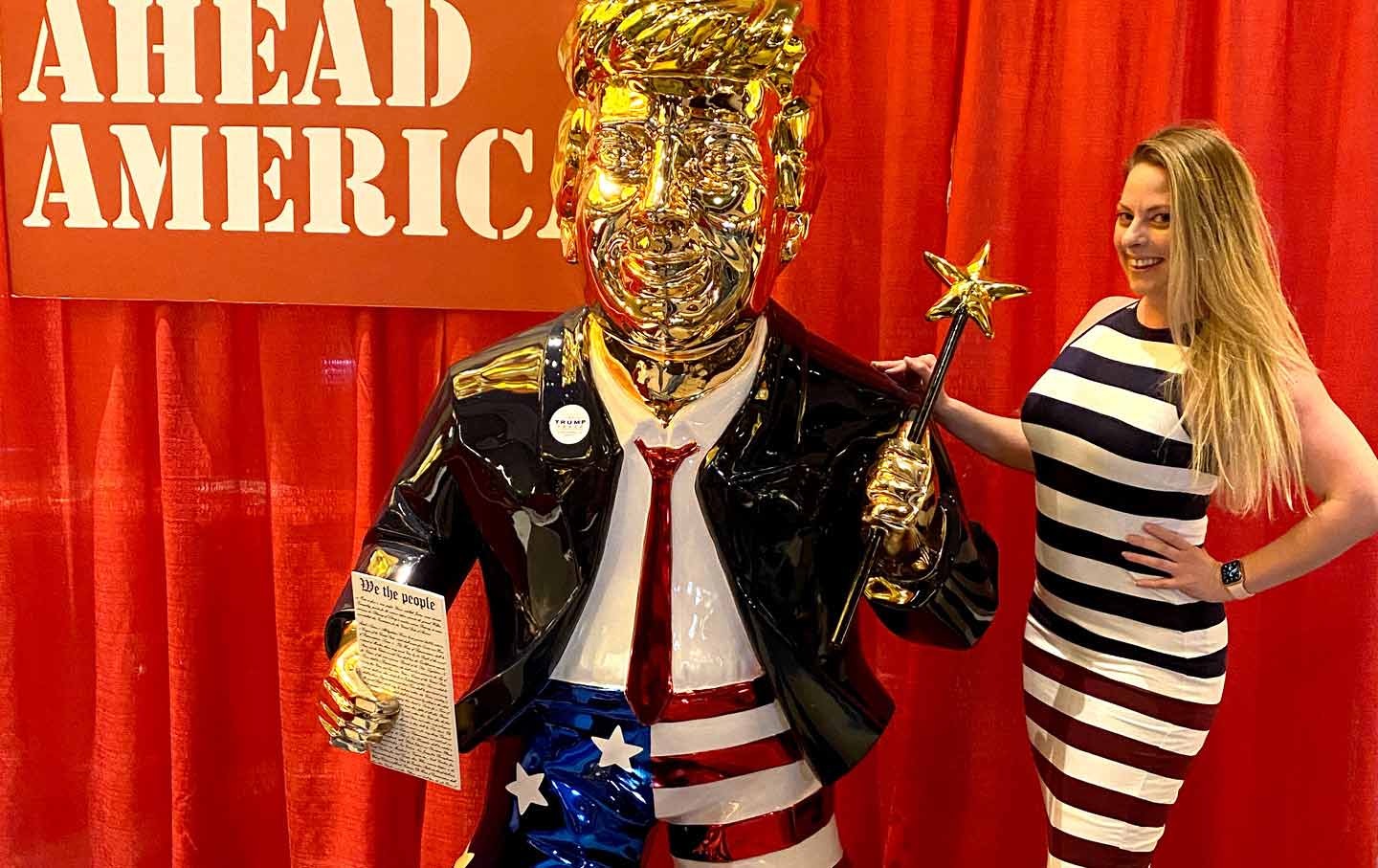
Undercover With the New Alt-Right
For 11 months, I pretended to be a far-right extremist. I discovered a radical youth movement trying to infiltrate the Republican Party.
What a bucket list of photo ops. Bucket of brain melted slop of course.Going to a Proud Boys riot with a neo-Nazi is not something I ever expected to do. But in August 2021, I found myself driving through downtown Portland, Ore., with an avowed white supremacist named Alex Nelson. We were on our way to the abandoned K-Mart parking lot that the Proud Boys had commandeered for their “Summer of Love” rally. The event marked the one-year anniversary of a “Back the Blue” demonstration that had become a brawl between the Proud Boys and militias on one side and anti-fascist counterprotesters on the other.
Earlier that week, Nelson, a man in his late 20s who was fond of discussing his “Anglo heritage,” had invited me to join him to watch what he assumed would be violent clashes. “Portland has canceled all parades and markets for the past year and a half. This is the only culture in Portland now. There will probably be a thousand spectators or more lining the bridges and sidewalks,” he assured me.
By then, I had been undercover with the far right for nine months, motivated by my belief that the fascist threat to the country was misunderstood by much of the press and far more dangerous than what was being reported. At first, I had planned only to sell the audio from “Stop the Steal” rallies to a podcast and write a couple of blog posts. But I found myself wanting to get a behind-the-scenes look at the far-right movement—to go to events from which the press was barred and observe extremists when they felt they were in their “safe space”—so the project grew into something far bigger: a long-term infiltration of the network of young white nationalists in America.
As we cruised the city, Nelson said, “The people who go to that parking lot, they’re highly violent, unhinged, very angry older Gen X or boomers. You can’t just show up—they have to know you. And they don’t know anyone under the age of 35.”
By contrast, he added, last night he had been to an Oregon Young Republicans meeting that was “full of normal, healthy, attractive young people.” As we pulled up to a red light, Nelson looked over at me and smirked. “But none of those people are going to be in the K-Mart parking lot.”
People in the political center and on the left tend to have a monolithic view of the far right. In reality, it is an expansive ecosystem that includes neo-Nazis, Christian nationalists, conspiracy theorists, anti-government militias, and white nationalists. These groups have some beliefs that conflict, but they are generally willing to overlook their differences. Still, not every group uses the same tactics to try to gain power.
I attended more than a dozen extremist and conspiracy events and went to ostensibly mainstream Republican conferences, including the Conservative Political Action Conference, or CPAC, the annual gathering of Republican activists, politicians, and hopefuls, and Turning Point USA’s Student Action Summit, and witnessed a radical youth movement trying to take over the GOP. Like a parasitic pilot fish, a robust fascist community follows the big Republican events into every town. They host shadow parties, receptions, and speeches as they work to recruit new members. The conservative establishment benefits from the presence of these farther-right gatherings; the extremists are often younger, well-dressed, and social-media savvy. While the more mainstream GOP organizations occasionally ban the most overt racists from a featured event, their attempts often feel half-hearted, and there are always other extremists who step up and fill the role as intermediaries between the white nationalists and normie conservatives.
Some of the neo-Nazis and fascists I met undercover in 2020 are working as congressional campaign staffers and helping to form congressional caucuses. They are meeting with leaders of far-right political parties in Italy and Hungary. They are leaders in their local Young Republican organizations. They have access to elected GOP officials at the national and local level.
Despite this growing influence, few of them or their true beliefs are known to the public. Some have worked hard to scrub themselves from the Internet or to curate their online personas; others operate in the shadows, so that people do not even know to look for them. But they network with each other, calling in favors and introductions. They’ve created a social maze that’s almost impossible to trace—unless you are invited to become one of them.
The Trump Youth: Gavin Wax, president of the Young Republican Club, speaks at a Trump rally outside the New York County Criminal Court in March 2023. (Alexi J. Rosenfeld / Getty Images)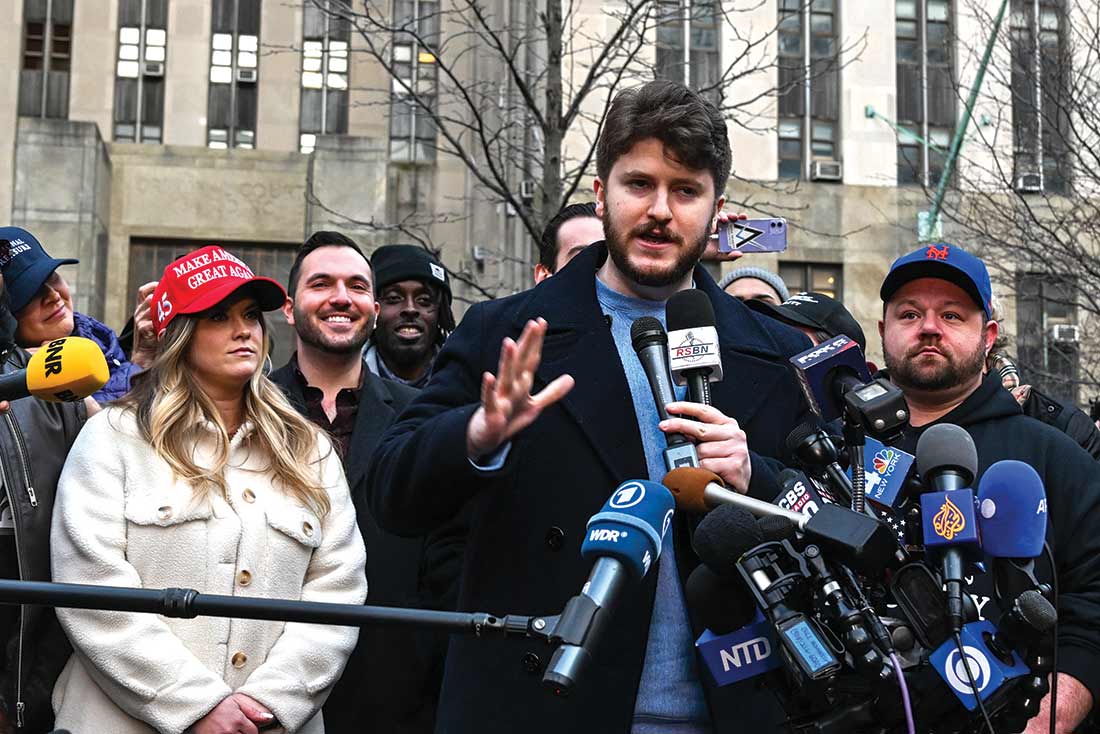
At just 29 years old, Gavin Wax, the president of the New York Young Republican Club, has already been working for years to push the Republican Party to the right and encourage those on the far right to enter mainstream GOP organizations. In 2016, Wax was the editor of Liberty Conservative, an online libertarian magazine. Alongside palatable pieces on libertarian candidates and policy, Wax published racist work by the white nationalist James Allsup. Ultimately, the magazine shifted so far right that multiple contributors quit. And since 2019, when he was elected president of the club, Wax has led a MAGA-style takeover of the previously moderate NYYRC. He was also the national spokesman for Republicans for National Renewal, an organization whose mission is to infiltrate the GOP with “hard core conservatives” and “unabashed America First patriots.”
In 2021, Turning Point USA made Wax an ambassador. TPUSA’s ambassador program is essentially an agreement to share the organization’s content, while also benefiting from TPUSA’s own audience.
Shortly after joining the TPUSA program, Wax appeared on a far-right podcast called Killstream. During the now-deleted interview, the host, Ethan Ralph, brought up Wax’s ambassadorship, something that would typically be mocked by the Killstream audience for being too mainstream. “I’m definitely kind of on the edge of where they stand ideologically,” Wax acknowledged. “My view is that we should use every institution we can to our benefit. If you have to shift the Overton window, shift it to the right, take it over from the inside…. If they’re gonna elevate my message and my platform, then we’re all square in my book.”
Some far-right figures deride TPUSA founder Charlie Kirk for not moving to the right enough, but Wax told Ralph he disagreed. “If they’re going to change their tune, if people are going to start to acquiesce to our movement—or, I don’t even know if I can say ‘our movement,’ but shifting to the right—then take the W.”
Working from within the system isn’t a strategy unique to Wax, who did not respond to my requests for an interview. Wax’s tactics have become a model for how to seize power. Increasingly, young far-right activists appear just reasonable enough to be let in the door, and once inside the establishment, they recruit people to the movement. Wax’s former colleague James Allsup did this well. After Allsup became a GOP precinct committee officer in Washington State, one neo-Nazi said on a podcast, “We can’t all be Andrew Anglin [the founder of the neo-Nazi outlet The Daily Stormer], but 10,000 of us can be James Allsup.”
The insurrection: Amanda Moore photographed Jacob Chansley, also known as the “QAnon Shaman,” at the January 6 attack at the Capitol.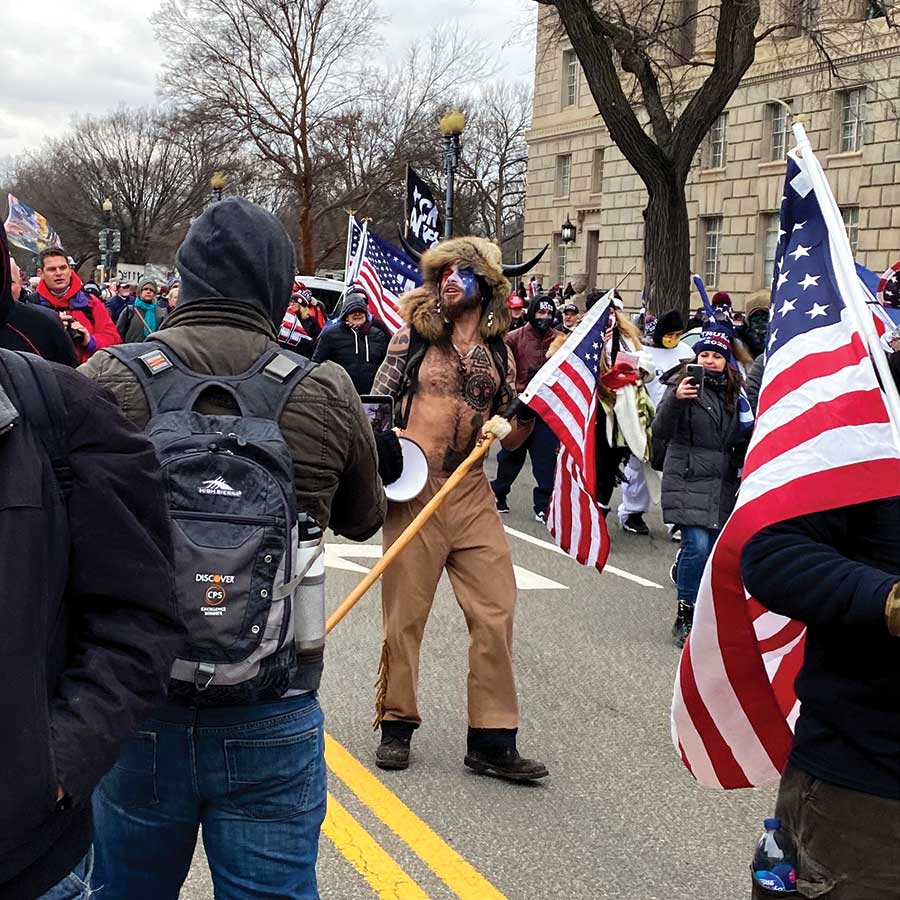
The far right is an exhausting, angry world to live in, but I know it well. I spent much of my life amid the paranoia and fear that drives the MAGA world. Though I grew up just outside Washington, D.C., I thought that speaking in tongues and believing that a Left Behind–style Rapture was imminent and that literal demons walked the earth were all part of mainstream Christianity. I was taught that Bill and Hillary Clinton were personally connected to the Antichrist and that Democrats planned to outlaw God and establish a one-world government. By the time I was 12, I was a libertarian, and that remained a part of my identity for years. I finally walked away from the party in my mid-20s after I witnessed the negative reactions of many of my fellow libertarians to the Black Lives Matter protests.
My lifelong interest in politics has often overlapped with my love of blogging. One of my favorite things to write about was my on-the-ground experiences: the 2014–15 Black Lives Matter marches, Trump’s inauguration, and then the protests that followed. I used to joke that if journalism paid decently, I would have been a writer instead of booking models for live events—but that stopped being a joke once Covid-19 shut down any public gatherings.
On January 6, 2021, texts poured in, some from people I had not spoken to in years. Ex-boyfriends, the woman who does my waxing, all reached out with the same general message: Are you there? I know you’re there. Be safe. (I am nothing if not predictable.)
So naturally, after attending and writing about January 6, I decided to buy a ticket for CPAC Orlando. The conference is usually held in the D.C. area, but in 2021, it was relocated to Florida to get around Covid restrictions. I decided I needed a more discreet recording system.
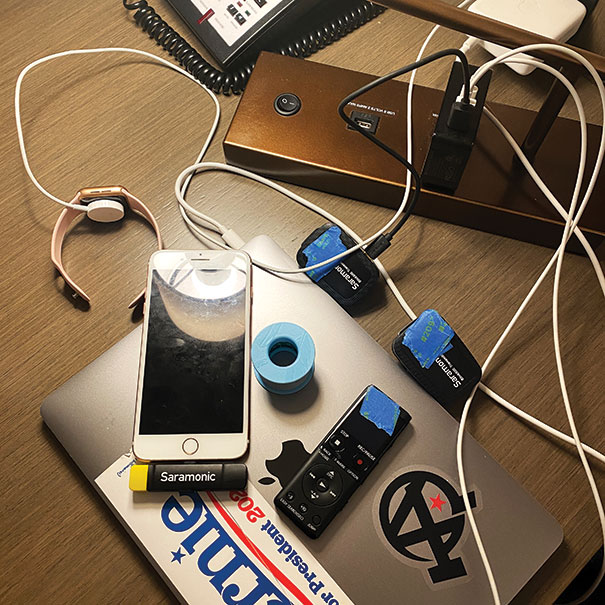
In the movies, spies have tiny audio recorders that perfectly capture sound, but the real-life options aren’t so glamorous. I ended up with a bulky Bluetooth microphone set that used my old iPhone as the receiver. I kept the iPhone in my purse, stuck blue painter’s tape over the microphone’s indicator lights, and blackened the tape with a Sharpie. If I wore a push-up bra and an opaque top, I could easily hide the microphone between my boobs.
My plan for CPAC was mostly to observe and record. I created a loose backstory. Much of my alter ego’s life was similar to mine: She was also named Amanda; she was from Annapolis, Md., where I had once lived; and she had been a libertarian for years—but where I went left, she turned far-right.
I spent very little time at CPAC itself. I was more interested in the surrounding parties and fundraisers, where attendees would feel comfortable among their like-minded fellows. One of these events was a reception hosted by Republicans for National Renewal (RNR). Their speakers for 2021 included the far-right provocateur Laura Loomer and US Representatives Marjorie Taylor Greene and Paul Gosar.
I arrived early, hoping to get a front-row seat. A man who looked to be in his 30s tried to make conversation with me; wearing a disheveled suit and sporting two gashes on his face, he didn’t seem like someone who would be capable of spearheading a fascist takeover of the GOP. “Trump has really changed things in Michigan,” he told me as I scanned the room for anyone who looked important. “Like, all the hard-core Trump people are now in positions of power. I’m the district chair. The leader of the Trump Republicans is the cochair of the party…. We’re really seizing that power over the GOP.”
Seizing power? Suddenly I was all ears. He introduced himself as Shane Trejo, and we chatted a bit before he went up to give a speech. Though he spoke for less than two minutes, Trejo urged the audience several times to grab one of the RNR booklets. “That pamphlet will tell you everything you need to do to become a precinct captain. And then we can, from the bottom up, throw out all these RINOs and make the GOP a solidly America First party.”
After the event, Trejo asked me for my phone number. The next morning, I texted him to find out if he was going to stick around for Trump’s speech. Trejo took the opportunity to hit on me: “We should meet at the double tree. U got a room for me to nap in? Lol.”
I rolled my eyes but decided to play nice. In addition to being the chairman of Michigan’s 11th District Republican Committee, Trejo was an election “whistleblower” and a writer for Big League Politics, a far-right propaganda outlet where he had published a video “verifying” his claims that poll workers in Detroit were trained to lie to voters. While the clip did not actually show this, it did get him mild notoriety in far-right circles—and earned the outlet a cease-and-desist letter from Michigan’s attorney general.
Trejo also wrote for Wax at Liberty Conservative. In 2017 and 2018, Trejo cohosted a podcast called Blood Soil and Liberty with fellow Liberty Conservative contributor Alex Witoslawski, an outspoken member of the white nationalist hate group Identity Evropa. “Blood and soil” is a reference to the idea in Nazi Germany that ethnic Germans have a deep and unique connection to the land. Trejo had registered the domain for the podcast just days after the 2017 “Unite the Right” rally in Charlottesville, Va., where marchers chanted “Blood and soil!”
In November of that year, Trejo and Witoslawski had guest-hosted an episode of Nationalist Review, a far-right podcast normally cohosted by James Allsup and Nick Fuentes. Every episode but one of Nationalist Review has been scrubbed from the Internet, but I received the one Trejo appeared on from Daniel Harper, whose podcast I Don’t Speak German tracks the far right. In the two-hour podcast, Trejo and Witoslawski doubled down on their support for Roy Moore, a serial assaulter of teenage girls (Trejo called him a “folk hero”); blamed minority outreach for the destruction of the Libertarian Party; and championed the idea of “free-market eugenics.”
So when RNR sent out an e-mail asking if anyone who had attended its reception wanted to get involved with the organization, I immediately replied yes. When Laura Loomer shared a video of Trejo on her Telegram channel, I texted him the link and gushed, “OMG you didn’t tell me you were famous!” When I met Roger Stone at an event, I sent Trejo a photo. In June, Trejo responded to one of my messages with an update on his “Stop the Steal” mission. “We are doing affidavits to demand a forensic audit in Michigan today. I’ve been notarizing affidavits all day.” He said they would be turning them in within two weeks. “We are gonna have a fuuuuuuckload.”
I asked what he thought would happen. “I don’t think the election results will be overturned. But we can drag them thru the mud,” he wrote back.
“Lol monopolize their time and expose their bullshit?”
“Ya,” he responded. “Like they did with trump and russia. Keep hammering these fucks and delegimizing [sic] them.”
In early June of 2021, I broke my arm. Fresh out of surgery and with nothing to do but spend time on my phone, I texted Trejo. Another CPAC was coming up, and I asked if he thought Trump would be canceled as a speaker for being too openly “America First.”
“He should be like ‘I got to say it…after seeing eight months of Biden, I’m feeling like Jan 6 was justified,’” Trejo replied.
This was the first time that January 6 had come up between us. I said that everyone wanted to pretend that it was the work of the FBI or antifa. Trejo immediately replied he didn’t believe that, and the people who did were “fuckin sheep. They are all such morons.” And then he described how he had experienced the Capitol riot:
During the riot, I’d heard people blaming antifa, and it didn’t take long for former Fox News host Tucker Carlson to suggest that FBI infiltrators were involved. The scapegoating was effective: Almost without fail, the boomer conspiracy theorists who populated QAnon conferences were quick to say January 6 was a peaceful day. But the fascists and those with ties to white nationalist groups were proud of storming the Capitol.I was at all three rallies. Conservatives were getting suppressed by police and became more angry and militant with every rally. The police literally enforced the fuckin vote steal. And protected antifa and black lives matter terrorists. Nobody as far as I can tell is talking about any of this except me. And I can’t talk about it loudly enough because I am an elected GOP official now. It’s so fuckin frustrating.
Trejo once texted me, “Jan 6 was some real life 1776 shit.”
Republican golden boy: Amanda Moore poses with a Donald Trump statue at the Conservative Political Action Conference in Orlando, Fla. (Courtesy of Amanda Moore)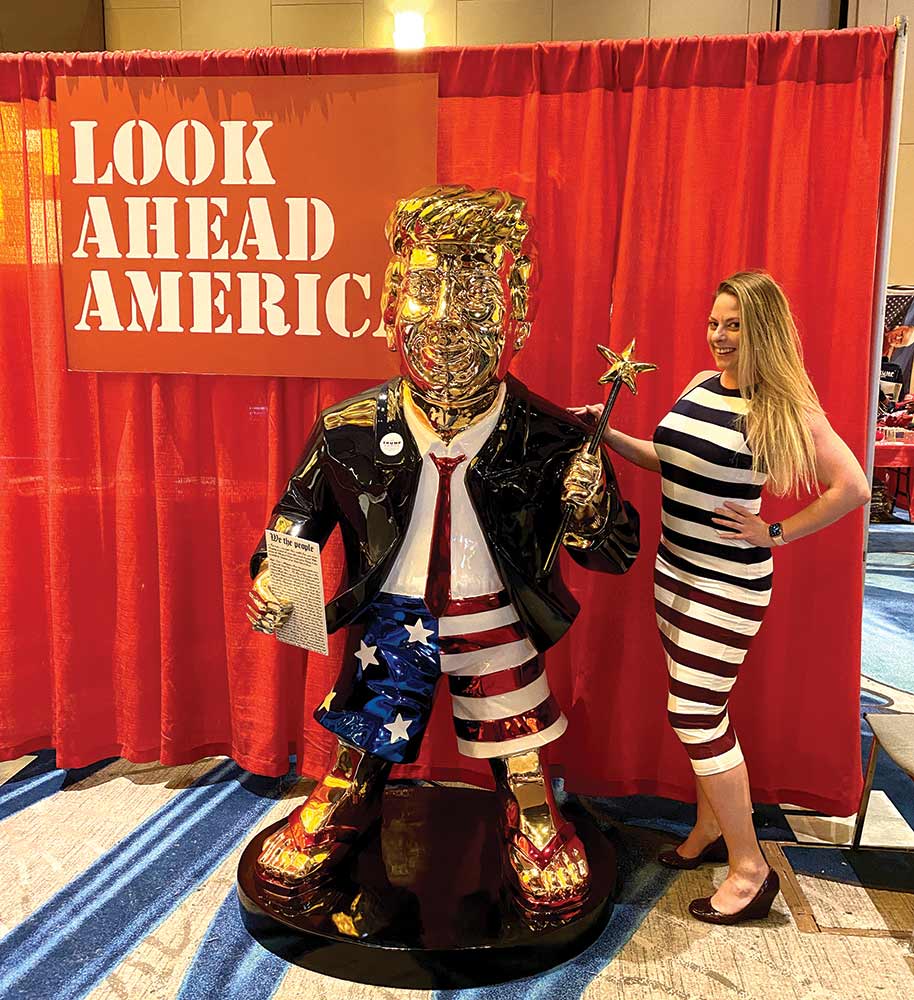
In July 2021, I met Alex Nelson for the first time at a cocktail reception during Turning Point USA’s Student Action Summit in Tampa. I was standing in line for a glass of wine when Nelson asked me what my vision for America was. To avoid encouraging people, I was always careful not to be more extreme than the people I met, so I deflected and asked what he wanted for the country.
“Uh… like a friendlier Nazi Germany,” Nelson responded.
Our conversation quickly turned to our disappointment in January 6. Nelson had been optimistic that hundreds of rioters around the country would stand their ground against the FBI. “None of them fought back. None of them Ruby Ridged themselves,” he noted.
“But they were all FBI and antifa, so it doesn’t matter,” I quipped sarcastically.
“Yeah, according to the conspiracy theories on the right,” Nelson said. “It’s like, no, they didn’t steal the election…. No, they weren’t antifa. Actually, guess what? Our people are upset.”
Nelson’s admission that Joe Biden had won the election took me by surprise. Whether they believed it or not, people like Trejo used the veneer of a stolen election to defend the January 6 insurrectionists. Nelson’s statement was far more direct: The Capitol rioters were “our people,” and January 6 was a riot of white rage.
Nelson said he’d tried to convince other members of the far right that Biden won the election, but the TPUSA attendees wouldn’t listen.
As we talked, the ballroom’s lights turned on, signaling that the staff wanted us to leave. Nelson told me there was a Project Veritas party across the street, and we headed over, debating whether New York City should be the capital of America. Once we were outside, people unaffiliated with TPUSA walked by, some of whom were not white. Nelson, undeterred, said loudly that we should kick out all the Jamaicans and Haitians who live in New York City.
“My mentality is the Anglo nation is one of the greatest nations to have ever walked the earth,” he said. “You know, we should not have to worry about like, ‘Oh my gosh, there’s a bunch of nasty Jamaicans and Haitians that are gonna rob me.’ Well, then beat them up, then beat the crap out of them, kick them out of the city, kick them out of the country, take their homes.”
I was relieved once we were inside, where it was unlikely anyone would get upset if they overheard him. Nelson’s glee in planning a genocide was disgusting. Nodding along with conspiracies was one thing, but condoning violence—even if it was just a fantasy—was a step too far. It turned out that Project Veritas had sprung for an open bar, and I took advantage of it. I had never been blackout drunk at an event before, but after listening to Nelson for hours, I granted myself an exception.
God, guns, and conspiracies: Amanda Moore attended the ReAwaken America Tour, a recruiting tool for the far right that helped unite Christian nationalists and conspiracy theorists. (Courtesy of Amanda Moore)
It was just a month after we met that I found myself in Portland with Nelson, trying to get a glimpse of the Proud Boys riot at the K-Mart parking lot. We quickly realized it wasn’t possible to view the area from the street. Instead, we aimlessly drove around as Nelson told me about his plans to dress up in a three-piece suit and attend “quality indoor Republican” events while carrying brochures from the Oregon and Washington Young Republicans clubs to give himself legitimacy. “I’ll just be like, ‘Oh well, my darling, I’m a nationalist, of course,’” he said.
In his view, the “big tent” version of conservatism that the boomers loved was a failure. “If demographics are indeed destiny, then that means the right wing is only five to 10 years away from being a full-on racist, nationalist organization. Because, I mean, there’s no non-white people at right-wing events.”
We drove back to the K-Mart and parked so we could walk around for a bit. Even though we were dressed neutrally, Nelson was on high alert, worried that a counterprotester would see through our disguises. When I walked too close to a group that was chanting and marching, he pulled me back. Big, bad Alex—ready to “beat the crap out of” Jamaicans in New York City, but afraid to walk by a little protest in daylight.
We made our way to the waterfront, where someone had tagged “Kill Patriot Front” on a pillar. Patriot Front is a white nationalist, neofascist hate group that produces professional-quality videos that feature masked members stenciling their logo and website address in public spaces or participating in marches meant to intimidate people. Prompted by the graffiti, Nelson told me about joining the organization.
He had traveled to Idaho for an interview with a Patriot Front recruiter. As they chatted, they placed the organization’s stickers around town and took photos of them. The recruiter, whom Nelson described as a “stupid redneck,” asked anti-Semitic questions, but they were just subtle enough that he played down his answers.
“Do you think a Jew can ever really be an American?” the recruiter asked.
“Well, to an extent, people can assimilate into the dominant culture,” Nelson told me he’d responded.
The recruiter told Nelson to keep at conservatism and attend a few more Trump rallies; maybe then he could join, but for now, he didn’t meet their standards. “I was extremely hard-core,” Nelson told me, complaining that he hadn’t been considered anti-Semitic enough. He said he then clarified to the recruiter, “I was trying to be a little polite here…. The only true Americans are white Anglo-Saxon Protestants. If you have even one drop of non-European blood, you do not belong here.”
This answer was satisfactory, and Nelson was added to the Patriot Front group chat. He picked a nickname from a preapproved list and joined their weekly phone calls, which were largely about putting up stickers. But Nelson quickly soured on the group’s culture of paranoia. “They were truly terrified that there were federal agents around every corner,” he said. “A lot of it is kind of a cult. Because they’re like, ‘Oh, none of us can ever reveal our faces, except our leader.’”
Afew weeks after I returned from Portland, photos of me started to appear on Telegram—but photos of the real me, not the fascist me. “Amanda Moore is a 33 year old communist infiltrator in the DC area,” an account dedicated to “doxing Antifa” wrote.
Within days, Trejo had blocked me on all platforms. I had a small, anonymous Twitter account from which I shared updates while undercover, and I decided to unmask myself. “Hey everyone. My name is Amanda, and I have been undercover as a MAGA since the 2020 November Stop the Steal Rally in Washington, D.C.,” I tweeted, adding photos of myself with various far-right figures.
Today, Trejo continues to peddle propaganda through his work at Big League Politics, defending Kanye West’s anti-Semitic statements and trivializing the suffering of the Sandy Hook parents who sued Alex Jones for defamation. He helped form a PAC in Michigan whose aim is to move the Republican Party to the right and has appeared on Roger Stone’s radio show. He recently promoted his article about the gang rape of an American woman in Pakistan with the tagline “This woman received some multiculturalism, good and hard.”
In fall 2021, Nelson became the chairman of RNR’s Oregon committee. In 2022, he became the Washington Young Republicans’ national committeeman, until he was kicked out for his racist beliefs. He also briefly worked for Republican Joe Kent’s congressional campaign but was fired when he was overheard advocating for white nationalism. (Matt Braynard, Kent’s campaign spokesman, told me that the campaign told Nelson to “‘get the fuck out of here’—and you can quote me on that.”)
Nelson was also a member of the European American Community, a group that supports thinly veiled white nationalism. The EAC has hosted introductory get-togethers alongside several mainstream events, including CPAC Dallas. On the first day of CPAC, the EAC asked its Instagram followers what American citizenship should be based on. The answers it reposted included: “Ideally 90-95% European ethnicities and the rest being made up of Western aligned”; “European ancestry 100% for the blacks who are already here they should get their own section”; and “Colonial Ancestry and its related stock, because it was formed by and for british protestants.”
The EAC formed a British Nationalists offshoot group, which has held recruitment receptions across the country. In November, the group announced that it would be holding one in D.C. at the Waldorf Astoria, formerly the Trump Hotel. For the first time in a year, I dug out my old iPhone and charged my microphones. I arrived 20 minutes before the event was to start.
Nelson arrived right on time and sat alone at a table. No one showed up. Eventually, I walked over. He was too engrossed in his phone to look up until I dropped my purse on his table. “Am I too late?” I asked, sitting down across from him.
It was clear from his expression that Nelson had not expected to see me. I asked him if he wanted to comment on anything he’d told me while I was undercover.
After a long pause, Nelson said, “I’m not a partisan.” He tried to explain that he was an “intellectual”—not really part of the right or the left.
After I was doxed, a researcher sent me an archived recording of a live stream that Nelson hosted. He praised the January 6 rioters and downplayed the severity of the threat, making jokes about boomers taking selfies in the Capitol. Using a Tucker Carlson–style affectation, Nelson told viewers, “Let’s just say it was a coup. Let’s say that it actually was a violent mob of revolutionary insurrectionists…. I would much prefer to live under the government that would be established by these patriotic revolutionaries than I am to live under the current government we have.”
But in the lobby of the Waldorf, Nelson had a different recollection of his words. “The stream I did about J6 said all my opinions on it. That the people were deluded. That it was very sad.”
It was a far cry from his wish that the rioters would have “Ruby Ridged” themselves—but that was before he knew he was speaking to a journalist.

Loomer looking uncomfortably like a goth friend am long acquainted with there. Tho am gonna guess she ain't cool enough to be playing any goth musics in goth bands so far, or likes to talk about cats.
The first politician on here is so infuriating yet very much important to observe to understand just how certain classes of people act under the knowledge they have concerning sway they've evidently got too used to exercising. And if like me, you don't know who or where he is, a google afterwards says he's a Florida republican politician, maga 'anti-"RINO"' election denier type, who thankfully lost their primary race due to the release of this video.
This fuck.
This fuck.
